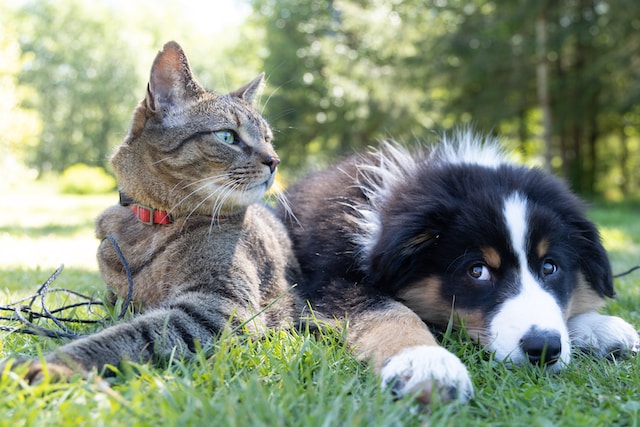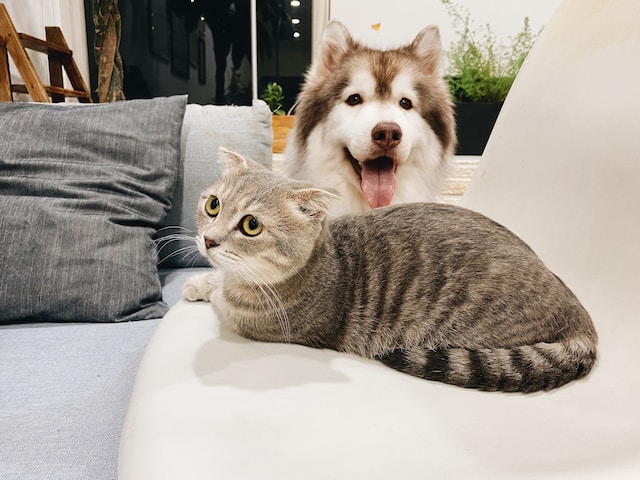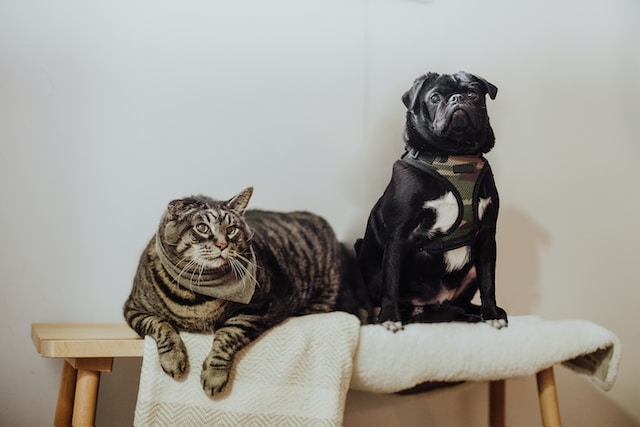
This article is contributed by guest writer Andy Redan (Freelance Writer).
Harmony At Last: Managing Cat And Dog Anxiety During Introductions
You’ve finally decided to expand your furry family and bring home a new pet. Whether you’re introducing a cat to a dog or vice versa, you know that first impressions matter. Achieving harmony between your pets may seem like a daunting task, but with some patience and careful planning, you can help ease their anxiety and set them up for successful coexistence.
In this article, we’ll guide you through the process of managing cat and dog anxiety during introductions so you can create a peaceful and loving home for all your pets.
Before the big day arrives, it’s essential to prepare yourself and your home for the first meeting between your pets. Creating a safe and controlled environment is key to reducing anxiety and preventing any potential conflicts. By gradually increasing their interaction, monitoring their body language, and establishing a routine, you’ll be well on your way to fostering a harmonious relationship between your cat and dog.
Let’s dive in and discover how to make this exciting transition as smooth and stress-free as possible for your furry friends.
Preparing for the First Meeting
So, you’re ready to prepare for the big first meeting between your cat and dog – let’s make sure it goes smoothly!
The first step is to create a safe and controlled environment for both your cat and dog. Set up designated areas for each pet that are separate but within sight or smell of each other. This will allow them to observe and get used to each other’s presence without feeling threatened.
Swap bedding or toys between their spaces to help them become familiar with the other’s scent. This will help manage their anxiety and ensure a smoother transition as they get to know one another.

Additionally, ensure both pets are comfortable and secure in their respective areas – that’ll help reduce anxiety and set the stage for a successful introduction.
In addition to these separate spaces, introduce your pets on neutral territory. This could be a room that neither pet has claimed as their own or an outdoor area where they can both feel at ease. Make sure to have a second person present to help manage the interaction and intervene if necessary.
Don’t worry too much, though – many dog breeds, especially Black Australian Shepherds, are naturally predisposed to get along with furry felines.
Keep both pets on leashes or harnesses to maintain control, and use treats or toys as positive reinforcement to encourage calm and friendly behavior. Remember, patience is key – it may take several introductions before your cat and dog start to feel comfortable around each other.
Gradually Increasing Interaction
You’re on the right track to helping your furry companions bond by increasing their interactions in a controlled and positive manner.
Gradually decrease the distance between them, always making sure to reward and praise them for calm behavior. Keep these interactions short and sweet at first, then slowly increase the duration as both pets become more comfortable in each other’s presence.

Once your cat and dog are more at ease with one another, you can start allowing them to interact more closely under your supervision. Be prepared to intervene if necessary, but try to let them explore each other without too much interference.
Continue to reinforce positive behavior with treats, praise, and affection. Keep in mind that the process of building a harmonious relationship between your pets can take time and patience, so don’t be discouraged if they don’t become best friends overnight.
Just keep working on gradually increasing their interaction and fostering positive experiences, and soon enough, your cat and dog will learn to coexist peacefully.
Monitoring Body Language and Stress Signals
Understanding your pets’ body language and recognizing red flags can prevent and manage potential conflicts or negative encounters between your dog and cat during their introduction process. Here are some red flags to watch out for in both dogs and cats:
Dog body language red flags:
1. Stiff posture or tense muscles
2. Growling or excessive barking
3. Raised hackles (hair along the spine)
4. Baring teeth or snapping
5. Ears pinned back
6. Direct and prolonged staring at the cat
7. Overly excited or anxious behavior, such as excessive panting or pacing
Cat body language red flags:
1. Hissing, spitting, or growling
2. Flattened ears
3. Dilated pupils
4. Arching back or puffing up fur
5. Swishing or lashing tail
6. Baring teeth or swiping with claws
7. Hiding or trying to escape
If you notice any of these red flags during the introduction process, it’s important to intervene immediately and separate your pets. Allow them some time to calm down, and reassess the situation before continuing with their interaction.
Adjust the pace of the introduction process as needed, and continue to monitor their body language closely throughout their interactions. By being vigilant and proactive in addressing potential issues, you can help create a positive, harmonious relationship between your dog and cat in the long run.
Establishing a Routine for Continued Success
Establishing a consistent routine for your pets is crucial in maintaining a successful and stress-free relationship between them. This means creating a schedule for feeding, playtime, and rest periods that both your cat and dog can adjust to. By having a set routine, your pets will feel more secure and less anxious, as they know what to expect throughout the day.

Make sure to also allocate separate spaces for each pet, where they can have their own bed, toys, and feeding area. This will help them feel more comfortable and reduce any potential territorial disputes.
In addition to the daily routine, make sure to reinforce positive behaviors and interactions between your cat and dog. Reward them with treats, praise, or extra playtime when they’re calm and friendly with one another. This will help them associate good things with being around each other.
Also, continue to monitor body language and stress signals, making adjustments to the routine as needed. Remember, patience and consistency are key in helping your pets form a harmonious relationship.
When Can You Leave Your Pets Alone Together?
After you’ve diligently prepared for the initial meeting, gradually increased interaction, monitored body language and stress signals, and established a routine, you might be wondering when it’s safe to leave your cat and dog alone together unsupervised.
Here are some guidelines to help you determine when they’re ready for that milestone:
1. Consistent positive interactions: Ensure that your cat and dog have consistently demonstrated positive and relaxed interactions for an extended period without any signs of aggression or fear. This could take days, weeks, or even months, depending on the individual pets.
2. Trust in their relationship: Observe your pets’ interactions and gauge whether they trust each other. Have they developed a bond or at least tolerate each other’s presence without showing signs of anxiety? Can they share a space without the need for constant supervision?
3. Gradual unsupervised time: Start by leaving them alone together for short periods and gradually increase the duration, always making sure you are nearby and able to intervene if necessary. This will help you assess their behavior when you’re not around and allow them to become comfortable with the idea of unsupervised time.
4. Set up safe spaces: Even after your cat and dog have established a peaceful coexistence, it’s essential to provide separate areas for each pet that they can retreat to if they feel stressed or overwhelmed. Make sure they know where their safe spaces are and can access them easily, even when you’re not around.
5. Trust your instincts: As a pet parent, you know your pets best. Trust your judgment and instincts when it comes to determining when it’s safe to leave them alone together. Don’t rush the process – every pet and situation is unique, so patience is key.
Conclusion
In conclusion, you’ve successfully managed your cat and dog’s anxiety during their introduction. By creating a safe environment, gradually increasing their interaction, and establishing a routine, you’ve set them up for a harmonious relationship.
Remember to always monitor their body language and stress signals, and adjust accordingly. With patience and consistency, your cat and dog will coexist peacefully, making your home a happy and stress-free space for the whole family.

Iflowers383@gmail.com Flowers
July 22, 2023 at 1:16 PMThanks for this insight. It is very helpful to me as I will be bringing a new dog into my house and want the interaction between my cat and new dog to go well.